

Hermann Mucke
Online Cloud Vergleich. Online Server Backup Software.
Mobile Tags. Pearltrees videos. Help. Blogging. A blog (a truncation of the expression web log)[1] is a discussion or informational site published on the World Wide Web and consisting of discrete entries ("posts") typically displayed in reverse chronological order (the most recent post appears first).
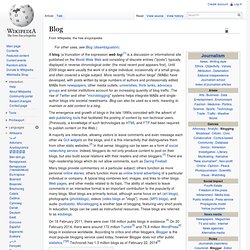
Until 2009 blogs were usually the work of a single individual, occasionally of a small group, and often covered a single subject. More recently "multi-author blogs" (MABs) have developed, with posts written by large numbers of authors and professionally edited. MABs from newspapers, other media outlets, universities, think tanks, advocacy groups and similar institutions account for an increasing quantity of blog traffic. The rise of Twitter and other "microblogging" systems helps integrate MABs and single-author blogs into societal newstreams. Blog can also be used as a verb, meaning to maintain or add content to a blog. History Origins Early blogs were simply manually updated components of common Web sites. Rise in popularity Types. State of the Blogosphere 2010 Introduction - Technorati Blogging. Welcome to Technorati's State of the Blogosphere 2010 report.
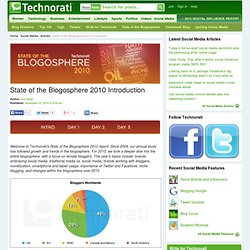
Since 2004, our annual study has followed growth and trends in the blogosphere. Technorati. Technorati is an Internet search engine for searching blogs.

By June 2008, Technorati was indexing 112.8 million blogs and over 250 million pieces of tagged social media.[3] The name Technorati is a blend of the words technology and literati, which invokes the notion of technological intelligence or intellectualism. Technorati was founded by Dave Sifry, with its headquarters in San Francisco, California, USA. Tantek Çelik was the site's Chief Technologist.
Technorati uses and contributes to open source software. Technorati has an active software developer community, many of them from open-source culture. The site won the SXSW 2006 awards for Best Technical Achievement and Best of Show.[4] It was nominated for a 2006 Webby Award for Best Practices, but lost to Flickr and Google Maps.[5] Technorati was recognized as one of the “2010 Hottest San Francisco Companies” by Lead411.[6] Technology[edit] Reception[edit] References[edit] Jump up ^ David Sifry (November 27, 2002).
External links[edit] Facebook (Wikipedia) This article is about the social networking service.
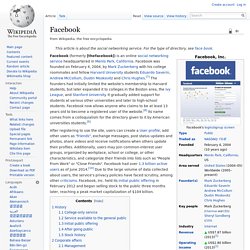
For the type of directory, see face book. Facebook (formerly [thefacebook]) is an online social networking service headquartered in Menlo Park, California. Facebook was founded on February 4, 2004, by Mark Zuckerberg with his college roommates and fellow Harvard University students Eduardo Saverin, Andrew McCollum, Dustin Moskovitz and Chris Hughes.[7] The founders had initially limited the website's membership to Harvard students, but later expanded it to colleges in the Boston area, the Ivy League, and Stanford University.
Facebook: Facts, Figures & Statistics For 2010 I thought I’d throw up another great social media infographic / visualisation / chart or what ever you want to call them!
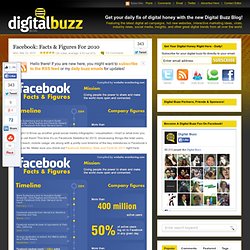
This time it’s on Facebook Statistics for 2010, showcasing things like total users, global reach, mobile usage .etc along with a pretty cool timeline of the key milestones in Facebook’s history so far. Make sure you check out Facebook Statistics, Stats and Facts for 2011 right here. Facebook Marketing Statistics, Demographics, Reports, and News – CheckFacebook. Twitter (Wikipedia) History Creation and initial reaction Twitter's origins lie in a "daylong brainstorming session" held by board members of the podcasting company Odeo.
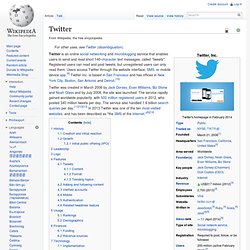
Dorsey, then an undergraduate student at New York University, introduced the idea of an individual using an SMS service to communicate with a small group.[15][16] The original project code name for the service was twttr, an idea that Williams later ascribed to Noah Glass,[17] inspired by Flickr and the five-character length of American SMS short codes. The developers initially considered "10958" as a short code, but later changed it to "40404" for "ease of use and memorability. ...we came across the word 'twitter', and it was just perfect.
50% of Tweets Consumed Come From Only 0.05% of Twitter Users [STUDY] A mere 20,000 Twitter users steal almost half of the spotlight on Twitter, which now ropes in a billion tweets every week.
![50% of Tweets Consumed Come From Only 0.05% of Twitter Users [STUDY]](http://cdn.pearltrees.com/s/pic/th/tweets-consumed-twitter-users-11495945)
That means only 0.05% of the social network’s user base attracts attention, according to a new Yahoo Research study titled, “Who Says What to Whom on Twitter.” Of the 260 million tweets with URLs that the study’s authors analyzed, nearly 50% of the tweets consumed were created by what they called “elite” users who fall into four categories: media, celebrities, organizations and bloggers. “Ordinary” users encompass everyone else. Like findings in previous studies, the researchers for this one conclude Twitter resembles an information-sharing hub rather than a social network, with the top generators garnering huge follower tallies but not following their content consumers in return. Unlike previous studies though, this one delves deeper into the production and flow of tweets. For access to a PDF of the full study, click here.
Most credible tweets come from people we trust, follow. Twitter users place the most faith in items retweeted by someone they trust, according to recent research, a finding that should make journalists and other influencers cautious about passing along suspect information.
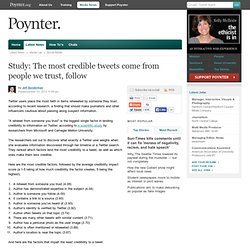
“A retweet from someone you trust” is the biggest single factor in lending credibility to information on Twitter, according to a scientific study by researchers from Microsoft and Carnegie Mellon University. The researchers set out to discover what exactly a Twitter user weighs when she evaluates information discovered through her timeline or a Twitter search. They ranked which factors lend the most credibility to a tweet, as well as which ones make them less credible. Trick or Tweet. #FollowFriday: The Anatomy of a Twitter Trend. Obsessed with the idea that Google doesn’t have the one right answer, in late 2008 Micah Baldwin joined Lijit Networks—his sixth startup—which believes each blogger has a right answer.

What if you didn't know who to follow on Twitter? Would you randomly start following people? Would you follow people you see mentioned by those you already follow? Twitter in business. An article in today's London Metro paper startlingly reports that in the Global Top 10 for businesses who use Twitter, just one is British – PriceWaterhouse.

Twitter celebrated it's 5th birthday yesterday amid the buzz of 200 million users and 1 billion tweets per week. While still not in the same super league as Facebook it is a growing platform and is gaining popularity. It's rare these days that you won't hear it mentioned in the media, most celebs have an account, nearly every TV show an official feed. Where businesses have already adopted, and grown comfortable with Facebook, Twitter appears to be unknown territory for most. How Can you Model Twitter Traffic? How to Predict the Spread of News on Twitter. Twitter has revolutionised the way millions of people receive news and the type of news they get. So it’s no surprise that there is huge interest in predicting what kind of stories are likely to spread furthest and fastest. One way to make this kind of prediction is to study how a story spreads soon after it is released into the wild.
Various groups have shown that this early popularity can be a good predictor of a story’s later spread. A couple of years ago, Bernardo Huberman and pals at HP’s Social Computing Lab in Palo Alto used this approach to predict the eventual box office revenues based on the rate of tweets about a film soon after it was released. The problem with this method is that the structure of the network can have a profound effect on the way tweets spread and this has little to do with the content and its appeal.
Twitter Unfollow Tool. Pharma TWANK (Twitter Rankings) 2011. Top Pharma Tweeters: Tracking Pharma’s Use of Twitter in Real-Time. About a year ago, I published a chart that looked like the one to the right in a post titled "Pharma Finds its Voice on Twitter. " This functional but not-so-pretty graphic featured known pharma companies actively tweeting, their Twitter handle, the date they joined, and the number of following, followers, and updates.
The pharma community response was positive, and everyone seemed to appreciate having a central resource for this type of info. Pharma on Twitter: Developing a Presence - a Nexus report. Does your company have a Twitter account? Want to know what all the buzz is about? Whether you are an experienced Twitter user or just curious, Pharma on Twitter: Developing a Presence, shares first-hand experiences from corporate tweeters on how and why pharmaceutical companies are using this medium as a communications tool. In the five years since GlaxoSmithKline set up the first industry corporate Twitter account, more than 130 pharmaceutical Twitter accounts have been created. Through a series of interviews with pharma industry communications specialists, the report examines the reasons why Pharma has turned to Twitter as part of its social media strategy and the benefits the microblogging platform brings.
Key quotes from the report: Why Twitter Matters Now in Biotech, and Why Executives Can’t Ignore it Anymore. Twitter for Health Campaigns (10 tips)